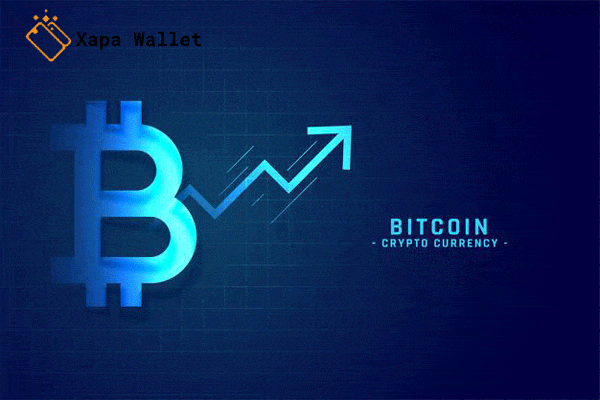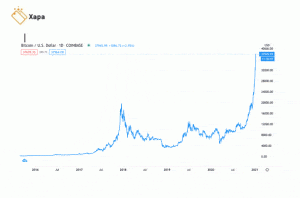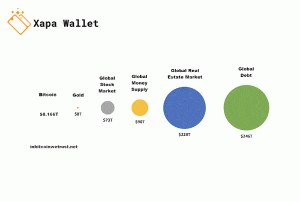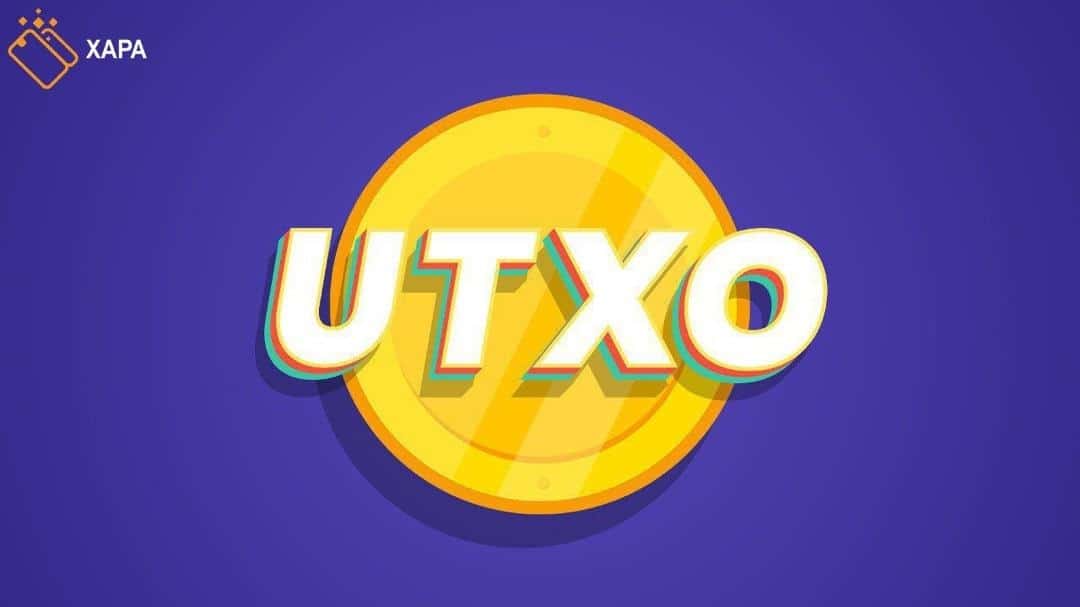
Bitcoin is the first and largest cryptocurrency in the world today, and its competitors have not been able to come close to its position even with their much more impressive ideas in the last ten years. It is no exaggeration to say that knowing where bitcoin is going is also knowing the future of cryptocurrencies. There have always been many questions about the existence of Bitcoin, the most important of which are these three:
Why is bitcoin worth it? What is Bitcoin support? Why do people buy something that does not exist externally?
Is Bitcoin Coin a Good Investment?
To answer these and above questions, just one sentence is enough: nothing is worthwhile unless the people of society accept it as valuable.
Predicting the potential value of Bitcoin in the next few years is something that investors can achieve with fundamental analysis. According to many professional analysts, using fundamental analysis to evaluate cryptocurrencies such as Bitcoin is much more complex than other assets such as stocks and Fiat currencies.
No one knows what awaits Bitcoin, not even Bitcoin suspects, not Bitcoin fans, not even Satoshi Nakamoto himself. There is no magic way to predict the future. Many of the sharpest minds in the cryptocurrency space welcome this uncertainty. They have no problem with the ambiguity of the future and even believe that this is one of the attractions of Bitcoin.
Elizabeth Stark, CEO of Lightning Labs, which is actively working to build the future of the Bitcoin network, says many of the key uses of Bitcoin over the next 10 years are what we now think They are considered insane, just like in the days before Wikipedia when the idea of an encyclopedia that anyone could edit seemed silly.
Bitcoin/US$ price 2016-21
Invest in Bitcoin
The identity of Bitcoin as “money” was shaken a little before it became a means of investing. The debate began in 2017 with a debate over the scalability of bitcoins (the issue of slow transactions and rising fees) when the network faced record-breaking demand and a staggering increase in transaction fees.
It is worth mentioning that in December 2017, at the same time as breaking the record Bitcoin cost Coinbase and bitcoin fees reached $ 50. At the time, the Bitcoin community was debating the future of the cryptocurrency, to the point that some called it a “civil war.”
As a result, on August 1, 2017, a hard fork was created in the Bitcoin blockchain network and a bitcoin cache was created. BitcoinCash tried to solve the problem of speed and fees by increasing the size of blocks, but most of the Bitcoin community believed that Bitcoin should remain stable and use SegWit and second-tier solutions such as Lightning Network for scalability.
On November 15, 2018, another fork was created in the Bitcoin Cash network, dividing it into two chains, Bitcoin Cash and Bitcoin Satoshi’s Vision (BSV for short).
Fortunately, Bitcoin recovered from the growing market downturn that pervaded the cryptocurrency industry and has since continued to grow. Also, amid these differences at the general level and the Bitcoin Coinbase price performance after the hard fork, bitcoin support and dominance became stronger and more addresses were created to hold bitcoins, which reduced market volatility. This is where the year 2020 began.
Here are three scenarios that can be used to predict three potential bitcoin routes over the next year.
Scenario 1: Allocate 1 to 2 percent of ordinary people’s capital to Bitcoin
According to the Federal Reserve, the wealth of US households reached $ 112 trillion by June 2020 (10% of people own two-thirds of the wealth). 1 to 2 percent of the $ 112 trillion equals $ 1.1 to $ 2.2 trillion in potential demand for Bitcoin (Fidelity’s latest report suggests a 5 percent chance of investing in Bitcoin).
- At present, the total bitcoin in circulation is about 18.5 million units. To simplify calculations, assume that a maximum of 21 million units of simple bitcoins is available for sale.
- If we divide the potential demand by the maximum supply, we will reach the price range of $ 56,000 to $ 112,000.
- This scenario does not include the rest of the world. According to the Credit Suisse Wealth Report in 2020, household capital worldwide will reach $ 400 trillion. If we consider investing 1 to 2% of the wealth of households in the world, we can think of the price range of 228,000 to 456,000 dollars. Will this happen in the next 12 months? Probably not. What about the next decade? In my opinion, the probability is very high.
Read More: Effects of bitcoine
Scenario 2: Allocate 2 to 3 percent of the wealth of rich people around the world to Bitcoin
According to Capgemini World Wealth Report 2020, the wealth of the richest people in the world at the end of 2019 was $ 74 trillion (about 13% of various investments, 14.6% of real estate, 17% Fixed income, 25% cash and cash equivalents and 30% stocks).
2 to 3 percent of $ 74 trillion equals $ 1.48 trillion to $ 2.22 trillion in potential demand.
- If we divide this amount of potential demand by the maximum supply, the price range is between $ 70,000 and $ 105,000.
- This scenario is based on global data, but only calculates the investment of wealthy people, assuming that these people have more assets to invest in and that it is the managers and advisors of investment companies who decide on their investment. Also, I have considered a longer range for their capital, because rich people are often in a better position to take risks to make higher profits along with controlled risk.
Scenario 3: Reaching Gold?
One of the old and common arguments is that if Bitcoin is widely accepted as the “digital and superior version of gold”, it can reach gold in terms of market value.
The current value of the gold market is $ 9 trillion, which is about 2% of the total wealth of the world and 12% of the wealth of the richest people in the world.
For Bitcoin to be worth 100 percent of its gold market value, it must reach a price of $ 428,000. Is this a point that can be considered for the next 12 months? Not very realistic. But can Bitcoin reach 20 to 25 percent of the value of the gold market (equivalent to 2.4 to 3 percent of the wealth of the world’s richest people) in the next 12 months? It is possible, and this hypothesis puts the price range at $ 80,000 to $ 110,000.
Other factors can add more positive and positive aspects to Bitcoin. Given that we are still in the early stages of public acceptance of bitcoins, I do not intend to overemphasize them, but only to outline the future of bitcoin.
- Potential allocation of corporate funds to invest in bitcoin. At present, we are witnessing the first signs of this trend with the investment of Square and Micro strategy companies. Recently, Square spent about 1.8 percent of its cash balance to buy 50 million bitcoins. Of course, estimating company demand for bitcoin is not easy; Because each company has its cash flow and growing trend that affects the degree of risk-taking in investing in various assets.
- Potential allocation of foreign exchange reserves of all independent countries. According to the International Monetary Fund, the global foreign exchange market reserves (Forex) as of June 2020 were $ 12 trillion, with the bulk of the top three reserve currencies: the dollar at $ 7 trillion (58.3%), the euro With $ 2 trillion (16.7%) and yen with $ 650 billion (5.4%). Is it possible for independent countries to allocate part of their Forex reserves to Bitcoin? In my opinion, this will be possible overtime, when the superiority of Bitcoin as a “value store” is established over the next 5 to 10 years. Assuming a 25 percent investment (equivalent to $ 3 trillion, slightly more than the euro capital), the price will increase by another $ 140,000. It takes a lot of time for Bitcoin to reach the US dollar as the top international reserve currency (if it can reach it at all). However, it is not impossible to place Bitcoin among the top three currencies in the world.
- Not all bitcoins are available for trading. There are currently approximately 18.5 million coins in circulation, of which about 10 percent have remained intact for more than 10 years. It is difficult to calculate how much bitcoin will be ready for sale at different prices.
None of the above has taken into account the dollar inflation rate (at least about 2 to 3% per annum) in the coming years. Also, none of these scenarios take into account the potential impact of the Bitcoin network in their calculations, the likelihood that Bitcoin as a unit of account will be more accepted and trusted.
Market capitalization of Bitcoin with gold and other markets








Robertbiafe
Helpful, friendly, and always patient.
can i get cheap lisinopril no prescription
Their patient education resources are top-tier.
PatrickSar
http://semaglupharm.com/# Semaglutide tablets without prescription
Jamesicent
http://crestorpharm.com/# CrestorPharm
BillyRow
Predni Pharm: Predni Pharm – PredniPharm
AlfonsoCep
prednisone over the counter uk: prednisone price canada – buy generic prednisone online
PatrickSar
https://semaglupharm.com/# Semaglu Pharm
BillyRow
Crestor Pharm: crestor itchy skin – does crestor cause leg cramps
Albertoorape
PredniPharm [url=https://prednipharm.com/#]can you buy prednisone in canada[/url] Predni Pharm
Jamesicent
https://prednipharm.com/# Predni Pharm
BillyRow
CrestorPharm: CrestorPharm – CrestorPharm
Albertoorape
rosuvastatin is used for [url=https://crestorpharm.com/#]5 mg crestor side effects[/url] crestor rhabdomyolysis
BillyRow
fda semaglutide shortage: Semaglu Pharm – rybelsus saving card
Albertoorape
Safe online pharmacy for Crestor [url=https://crestorpharm.shop/#]what are side effects of crestor[/url] Online statin therapy without RX
PatrickSar
https://semaglupharm.com/# Semaglu Pharm
AlfonsoCep
where to buy prednisone 20mg no prescription: prednisone 30 mg daily – Predni Pharm
Jamesicent
https://prednipharm.shop/# Predni Pharm
Albertoorape
Crestor Pharm [url=https://crestorpharm.shop/#]rosuvastatin size[/url] generic for rosuvastatin
AlfonsoCep
Predni Pharm: buy prednisone 20mg without a prescription best price – prednisone 5 mg cheapest
BillyRow
Atorvastatin online pharmacy: lipitor label – Discreet shipping for Lipitor
Albertoorape
Discreet shipping for Lipitor [url=https://lipipharm.shop/#]LipiPharm[/url] atorvastatin dental side effects
AlfonsoCep
Crestor Pharm: Crestor home delivery USA – Affordable cholesterol-lowering pills
Albertoorape
what are the long-term side effects of lipitor [url=http://lipipharm.com/#]atorvastatin[/url] USA-based pharmacy Lipitor delivery
Jamesicent
http://semaglupharm.com/# SemagluPharm
AlfonsoCep
prednisone otc price: Predni Pharm – prednisone best price
PatrickSar
http://semaglupharm.com/# SemagluPharm
BillyRow
prednisone 5 50mg tablet price: PredniPharm – Predni Pharm
Albertoorape
Lipi Pharm [url=https://lipipharm.com/#]LipiPharm[/url] Lipi Pharm
AlfonsoCep
PredniPharm: Predni Pharm – prednisone pill 20 mg
PatrickSar
https://semaglupharm.shop/# rybelsus 14 mg weight loss
AlfonsoCep
why am i not losing weight on rybelsus: SemagluPharm – Semaglu Pharm
Jamesicent
https://prednipharm.com/# prednisone capsules
Albertoorape
CrestorPharm [url=http://crestorpharm.com/#]Crestor Pharm[/url] No doctor visit required statins
BillyRow
cholesterol crestor: can rosuvastatin cause erectile dysfunction – Generic Crestor for high cholesterol
AlfonsoCep
Semaglu Pharm: Safe delivery in the US – SemagluPharm
Albertoorape
buy prednisone online no prescription [url=https://prednipharm.com/#]prednisone prescription drug[/url] PredniPharm
AlfonsoCep
Discreet shipping for Lipitor: USA-based pharmacy Lipitor delivery – Lipi Pharm
BillyRow
Predni Pharm: where to buy prednisone in australia – purchase prednisone no prescription
Jamesicent
http://crestorpharm.com/# CrestorPharm
Albertoorape
Lipi Pharm [url=https://lipipharm.com/#]Affordable Lipitor alternatives USA[/url] LipiPharm
AlfonsoCep
Buy cholesterol medicine online cheap: CrestorPharm – CrestorPharm
BillyRow
FDA-approved Rybelsus alternative: Rybelsus for blood sugar control – starting dose of semaglutide
Robertkab
my canadian pharmacy: Canada Pharm Global – cross border pharmacy canada
MichelBat
Meds From Mexico: Meds From Mexico – Meds From Mexico
Robertwheew
http://medsfrommexico.com/# mexican rx online
JamesHarie
http://indiapharmglobal.com/# India Pharm Global
MichelBat
pharmacies in mexico that ship to usa: Meds From Mexico – Meds From Mexico
Samuelfap
canada drug pharmacy [url=http://canadapharmglobal.com/#]canadian pharmacy mall[/url] canada rx pharmacy world
Robertkab
India Pharm Global: online pharmacy india – top 10 pharmacies in india
MichelBat
India Pharm Global: India Pharm Global – India Pharm Global
Samuelfap
India Pharm Global [url=https://indiapharmglobal.com/#]indianpharmacy com[/url] India Pharm Global
Robertkab
buying prescription drugs in mexico online: buying from online mexican pharmacy – Meds From Mexico
MichelBat
Meds From Mexico: Meds From Mexico – best online pharmacies in mexico
Samuelfap
mexico pharmacies prescription drugs [url=http://medsfrommexico.com/#]Meds From Mexico[/url] purple pharmacy mexico price list
Robertkab
India Pharm Global: indian pharmacy – indian pharmacy
MichelBat
online shopping pharmacy india: India Pharm Global – India Pharm Global
JamesHarie
https://indiapharmglobal.com/# indian pharmacy online
Samuelfap
indian pharmacy paypal [url=http://indiapharmglobal.com/#]reputable indian online pharmacy[/url] Online medicine order
Robertkab
India Pharm Global: India Pharm Global – indian pharmacy online
MichelBat
cheapest pharmacy canada: prescription drugs canada buy online – pharmacy rx world canada
Samuelfap
canadianpharmacymeds [url=https://canadapharmglobal.shop/#]Canada Pharm Global[/url] canadian pharmacy world
Robertkab
canadian pharmacy online store: Canada Pharm Global – canadian pharmacies
MichelBat
Meds From Mexico: Meds From Mexico – Meds From Mexico
JamesHarie
http://canadapharmglobal.com/# canadian drugs online
Samuelfap
cheap canadian pharmacy online [url=http://canadapharmglobal.com/#]Canada Pharm Global[/url] canadian pharmacy ltd
MichelBat
India Pharm Global: India Pharm Global – buy prescription drugs from india
Samuelfap
buy medicines online in india [url=http://indiapharmglobal.com/#]India Pharm Global[/url] best india pharmacy
Robertkab
medication from mexico pharmacy: purple pharmacy mexico price list – Meds From Mexico
MichelBat
India Pharm Global: India Pharm Global – India Pharm Global
JamesHarie
https://indiapharmglobal.shop/# India Pharm Global
Samuelfap
India Pharm Global [url=https://indiapharmglobal.shop/#]indianpharmacy com[/url] India Pharm Global
Clintondit
ozempic 1 mg prezzo svizzera: farmaco deursil – EFarmaciaIt
WilliamDriva
Papa Farma: opiniones verificadas es fiable – mejor antimosquitos elГ©ctrico ocu
HenryGak
https://svenskapharma.shop/# Svenska Pharma
JosephWef
göra egen saltvattenspray [url=http://svenskapharma.com/#]beställ medicin på nätet[/url] Svenska Pharma
Clintondit
Rask Apotek: Rask Apotek – Rask Apotek
WilliamDriva
apotek koronavaksine: apotek ГҐpent pГҐ sГёndag – salvie te apotek
RobertTwelf
http://efarmaciait.com/# nu3 italia
WilliamDriva
Rask Apotek: Rask Apotek – Rask Apotek
HenryGak
https://papafarma.com/# Papa Farma
JosephWef
Papa Farma [url=http://papafarma.com/#]Papa Farma[/url] comprar ozempic 0 50
WilliamDriva
EFarmaciaIt: di base 25000 prezzo – prezzo cialis 20 mg 4 compresse
RobertTwelf
https://papafarma.shop/# ozempic comprar amazon
Clintondit
primolut nor 10 mg prezzo: EFarmaciaIt – EFarmaciaIt
WilliamDriva
Papa Farma: farmacia central barcelona – Papa Farma
JosephWef
Svenska Pharma [url=http://svenskapharma.com/#]Svenska Pharma[/url] Svenska Pharma
WilliamDriva
l’ordine del tempo recensioni negative: EFarmaciaIt – EFarmaciaIt
RobertTwelf
https://papafarma.com/# Papa Farma
HenryGak
https://efarmaciait.shop/# EFarmaciaIt
JosephWef
Rask Apotek [url=https://raskapotek.shop/#]Rask Apotek[/url] Rask Apotek
Clintondit
EFarmaciaIt: EFarmaciaIt – tiche 100
JosephWef
kveldsГҐpent apotek [url=http://raskapotek.com/#]apotek sГёndagsГҐpent[/url] Rask Apotek
HenryGak
https://svenskapharma.com/# köpa medicin
RobertTwelf
http://raskapotek.com/# l-theanine apotek
Clintondit
Svenska Pharma: q10 och blodtrycksmedicin – normal fransar
HenryGak
http://papafarma.com/# Papa Farma
WilliamDriva
bestГ¤ll lГ¤kemedel: kГ¶pa medicin pГҐ nГ¤tet utan recept – Svenska Pharma
JosephWef
gfarmacia [url=https://papafarma.com/#]cual es la farmacia online mas barata[/url] casenlax sobres precio
RobertTwelf
http://papafarma.com/# Papa Farma
JosephWef
apotek serum [url=http://svenskapharma.com/#]Svenska Pharma[/url] foundation stick bäst i test
JosephWef
bijuva online [url=https://efarmaciait.com/#]ismigen 30 compresse prezzo[/url] EFarmaciaIt
WilliamDriva
vitamin b12 apotek: apotek schampo – apotek mascara
RobertTwelf
https://svenskapharma.shop/# Svenska Pharma
HenryGak
http://papafarma.com/# Papa Farma
JosephWef
farma boutique [url=https://papafarma.shop/#]Papa Farma[/url] Papa Farma
MelvinMob
Pharma Confiance: sevrage cannabique homГ©opathie – comment prendre le solupred
Williamhoids
revatio online pharmacy [url=http://pharmaconnectusa.com/#]rx pharmacy shop[/url] pharmacy course online
EdwardbloOx
http://pharmaconfiance.com/# Pharma Confiance
Albertquisk
gdf telephone: 50 g huile en ml – parapharmacie dufour
ChrisQuere
https://medicijnpunt.shop/# Medicijn Punt
MelvinMob
medikamente preisvergleich testsieger: PharmaJetzt – PharmaJetzt
EdwardbloOx
https://medicijnpunt.shop/# medicatie online
Williamhoids
mieux que le viagra [url=http://pharmaconfiance.com/#]Pharma Confiance[/url] Pharma Confiance
Albertquisk
Medicijn Punt: medicijnen bestellen bij apotheek – Medicijn Punt
MelvinMob
apotheke shop online: PharmaJetzt – PharmaJetzt
ChrisQuere
https://pharmaconfiance.com/# Pharma Confiance
Williamhoids
buy synthroid online pharmacy [url=http://pharmaconnectusa.com/#]which pharmacy has the best price on viagra[/url] PharmaConnectUSA
Albertquisk
PharmaJetzt: shop spotheke – PharmaJetzt
MelvinMob
Pharma Jetzt: Pharma Jetzt – ihre apotheken de
EdwardbloOx
http://pharmaconfiance.com/# Pharma Confiance
Williamhoids
versandapoteken [url=https://pharmajetzt.shop/#]apotheke deutschland[/url] online apothek
Albertquisk
cleocin online pharmacy: PharmaConnectUSA – PharmaConnectUSA
MelvinMob
Pharma Confiance: Pharma Confiance – paraphramacie
ChrisQuere
https://medicijnpunt.com/# online medicijnen bestellen
Williamhoids
apotheek nl online [url=https://medicijnpunt.shop/#]mijn medicijn bestellen[/url] Medicijn Punt
MelvinMob
acheter mГ©dicament en ligne avec ordonnance: Pharma Confiance – poudre parapharmacie
Williamhoids
Medicijn Punt [url=http://medicijnpunt.com/#]farma online[/url] bestellen medicijnen
Albertquisk
Pharma Confiance: Pharma Confiance – gdm auto
MelvinMob
Pharma Jetzt: Pharma Jetzt – PharmaJetzt
ChrisQuere
https://pharmajetzt.com/# internetapotheken preisvergleich
Williamhoids
Pharma Jetzt [url=http://pharmajetzt.com/#]deutschland apotheke[/url] Pharma Jetzt
Albertquisk
Pharma Jetzt: Pharma Jetzt – online apoteken
MelvinMob
Pharma Connect USA: synthroid target pharmacy – online pharmacy suboxone
EdwardbloOx
http://pharmajetzt.com/# PharmaJetzt
Albertquisk
online apotheke de: Pharma Jetzt – PharmaJetzt
MelvinMob
MedicijnPunt: Medicijn Punt – Medicijn Punt
ChrisQuere
http://pharmaconfiance.com/# Pharma Confiance
Albertquisk
monuril comprimГ©: Pharma Confiance – filorga avis 60 millions de consommateur
MelvinMob
MedicijnPunt: apteka nl – netherlands pharmacy online
Williamhoids
PharmaJetzt [url=http://pharmajetzt.com/#]PharmaJetzt[/url] PharmaJetzt
MelvinMob
PharmaJetzt: PharmaJetzt – PharmaJetzt
ChrisQuere
https://medicijnpunt.shop/# internetapotheek nederland
MelvinMob
pharmacie online: Pharma Jetzt – shop a
Albertquisk
online doktersrecept: apteka nl online – MedicijnPunt
EdwardbloOx
https://pharmaconnectusa.com/# permethrin uk pharmacy
MelvinMob
Pharma Confiance: Pharma Confiance – acheter viagra cialis sans ordonnance
Williamhoids
wedgewood pharmacy [url=http://pharmaconnectusa.com/#]PharmaConnectUSA[/url] buy cialis pharmacy
ChrisQuere
https://medicijnpunt.com/# MedicijnPunt
MelvinMob
Medicijn Punt: п»їmedicijnen bestellen – aptoheek
Williamhoids
gГјnstiger apotheke [url=http://pharmajetzt.com/#]PharmaJetzt[/url] apotal online apotheke
MelvinMob
viagra no prescription online pharmacy: Pharma Connect USA – cheap online pharmacy viagra
Albertquisk
PharmaJetzt: Pharma Jetzt – online-apotheke testsieger
Williamhoids
Pharma Confiance [url=https://pharmaconfiance.shop/#]pharla[/url] Pharma Confiance
MelvinMob
pharmacie notre dame de santГ©: Pharma Confiance – Pharma Confiance
Albertquisk
animal rx pharmacy: PharmaConnectUSA – gabapentin pharmacy prices
Williamhoids
MedicijnPunt [url=https://medicijnpunt.com/#]MedicijnPunt[/url] Medicijn Punt
MelvinMob
apotheek spanje online: Medicijn Punt – online apotheek zonder recept ervaringen
Albertquisk
apotheke medikamentencheck: apotheke medikamentencheck – europa apotheek venlo online
Williamhoids
Medicijn Punt [url=https://medicijnpunt.shop/#]farmacia online[/url] online medicatie bestellen
MelvinMob
MedicijnPunt: mijn apotheek – Medicijn Punt
Albertquisk
medikamente bestellen ohne rezept: Pharma Jetzt – medicine online shop
Williamhoids
Pharma Connect USA [url=https://pharmaconnectusa.shop/#]PharmaConnectUSA[/url] prometrium online pharmacy
MelvinMob
PharmaConnectUSA: azithromycin mexico pharmacy – Pharma Connect USA
Albertquisk
uk online pharmacy: PharmaConnectUSA – PharmaConnectUSA
Williamhoids
doctolib luxembourg [url=http://pharmaconfiance.com/#]gode 24 cm[/url] normandie pionniГЁres
MelvinMob
Pharma Jetzt: PharmaJetzt – PharmaJetzt
EdwardbloOx
https://pharmaconnectusa.shop/# PharmaConnectUSA
Albertquisk
online medikamente: shop apotheke medikamente – Pharma Jetzt
MelvinMob
medicijn recept: mijn apotheek medicijnen – medicatie bestellen online
EdwardbloOx
http://pharmaconfiance.com/# Pharma Confiance
Albertquisk
PharmaConnectUSA: PharmaConnectUSA – PharmaConnectUSA
Williamhoids
PharmaConnectUSA [url=https://pharmaconnectusa.shop/#]online pharmacy ultram[/url] PharmaConnectUSA
MelvinMob
Pharma Jetzt: Pharma Jetzt – medikamenten preisvergleich
Albertquisk
pille danach apotheke online: Pharma Jetzt – Pharma Jetzt
ChrisQuere
https://pharmaconfiance.com/# Pharma Confiance
EdwardbloOx
https://pharmaconnectusa.com/# PharmaConnectUSA
Williamhoids
MedicijnPunt [url=https://medicijnpunt.com/#]Medicijn Punt[/url] Medicijn Punt
Albertquisk
Medicijn Punt: medicijnen kopen met ideal – online apotheek – gratis verzending
EdwardbloOx
https://pharmaconfiance.com/# achat ghb
Albertquisk
online apotheek zonder recept: Medicijn Punt – apotheke online
Williamhoids
grossiste parapharmacie [url=https://pharmaconfiance.com/#]Pharma Confiance[/url] pharmacie de garde Г montpellier aujourd’hui
MelvinMob
Pharma Confiance: Pharma Confiance – Pharma Confiance
Albertquisk
Medicijn Punt: online apotheek recept – apotheek apotheek
EdwardbloOx
https://pharmaconnectusa.shop/# pharmacy online uk
MelvinMob
medi apotheke: PharmaJetzt – PharmaJetzt
Williamhoids
Medicijn Punt [url=https://medicijnpunt.shop/#]MedicijnPunt[/url] Medicijn Punt
Albertquisk
online medicijnen bestellen met recept: MedicijnPunt – MedicijnPunt
MelvinMob
Medicijn Punt: Medicijn Punt – apotheek winkel 24 review
EdwardbloOx
https://pharmajetzt.com/# Pharma Jetzt
ChrisQuere
http://pharmajetzt.com/# Pharma Jetzt
Albertquisk
pharmacie de garde aujourd’hui strasbourg: chat thГ©rapeutique prix – sirop avec pompe
MelvinMob
achat viagra espagne pharmacie: pharmacie vedel – Pharma Confiance
Williamhoids
medicijnen aanvragen apotheek [url=https://medicijnpunt.shop/#]Medicijn Punt[/url] bestellen apotheek
EdwardbloOx
https://pharmajetzt.com/# apotheke versandkostenfrei
MelvinMob
PharmaConnectUSA: Pharma Connect USA – caremark specialty pharmacy
Albertquisk
Pharma Jetzt: apotheke versandkostenfrei ab 10 euro – Pharma Jetzt
Williamhoids
Pharma Jetzt [url=https://pharmajetzt.shop/#]PharmaJetzt[/url] mediamarkt in meiner nähe
ChrisQuere
http://pharmajetzt.com/# PharmaJetzt
MelvinMob
PharmaConnectUSA: Pharma Connect USA – PharmaConnectUSA
Albertquisk
PharmaConnectUSA: Pharma Connect USA – Pharma Connect USA
MelvinMob
Pharma Connect USA: pharmacy degree online – PharmaConnectUSA
Albertquisk
pharmacie du soleil strasbourg: Pharma Confiance – Pharma Confiance
EdwardbloOx
https://pharmaconfiance.shop/# shampoing avene
MelvinMob
Pharma Jetzt: PharmaJetzt – online apotheken vergleich
Albertquisk
mexican pharmacy azithromycin: online pharmacy viagra review – envision rx pharmacy help desk
ChrisQuere
https://pharmaconnectusa.com/# xlpharmacy viagra
EdwardbloOx
http://pharmaconfiance.com/# pharmacie libération nice
MelvinMob
Pharma Confiance: Pharma Confiance – achat viagra en europe
Williamhoids
MedicijnPunt [url=https://medicijnpunt.com/#]Medicijn Punt[/url] landelijke apotheek
Albertquisk
Pharma Confiance: saxenda achat sans ordonnance – Pharma Confiance
registrarse en www.binance.com
Thank you for your sharing. I am worried that I lack creative ideas. It is your article that makes me full of hope. Thank you. But, I have a question, can you help me?
MelvinMob
Pharma Confiance: Pharma Confiance – Pharma Confiance
Williamhoids
MedicijnPunt [url=https://medicijnpunt.com/#]apotheke[/url] mijn apotheek online
MelvinMob
PharmaConnectUSA: Pharma Connect USA – world pharmacy store
ChrisQuere
https://pharmajetzt.com/# onlinr apotheke
Albertquisk
shop apot: klack 95 – online apotheke pille danach
EdwardbloOx
https://medicijnpunt.shop/# MedicijnPunt
MelvinMob
Pharma Jetzt: Pharma Jetzt – apotheken versand
Williamhoids
MedicijnPunt [url=https://medicijnpunt.shop/#]medicatie bestellen apotheek[/url] medicijnen bestellen apotheek
MelvinMob
MedicijnPunt: holland apotheke – MedicijnPunt
EdwardbloOx
http://pharmaconnectusa.com/# buy nolvadex online pharmacy
Albertquisk
Pharma Connect USA: safest online pharmacy – zyrtec d online pharmacy
ChrisQuere
http://pharmaconfiance.com/# pharmacie france en ligne
MelvinMob
MedicijnPunt: online apotheke – betrouwbare online apotheek
Williamhoids
pharmacy symbol rx [url=https://pharmaconnectusa.shop/#]pharmacy store fixtures and design[/url] Pharma Connect USA
Albertquisk
Pharma Confiance: Pharma Confiance – parapharmacie rennes
EdwardbloOx
http://medicijnpunt.com/# MedicijnPunt
OscarLag
canadian pharmacy 24h com: CanRx Direct – onlinecanadianpharmacy 24
JamesPoura
IndiMeds Direct [url=https://indimedsdirect.com/#]IndiMeds Direct[/url] IndiMeds Direct
OscarLag
TijuanaMeds: TijuanaMeds – TijuanaMeds
JosephFaugh
buying from online mexican pharmacy: mexican mail order pharmacies – TijuanaMeds
DavidOrbiz
http://canrxdirect.com/# trusted canadian pharmacy
JosephFaugh
canada pharmacy online: CanRx Direct – canadian pharmacy
JamesPoura
Online medicine order [url=https://indimedsdirect.com/#]IndiMeds Direct[/url] IndiMeds Direct
JosephFaugh
online pharmacy canada: CanRx Direct – canadian pharmacy sarasota
Stevegip
http://canrxdirect.com/# canadian drug stores
JamesPoura
mail order pharmacy india [url=https://indimedsdirect.shop/#]online shopping pharmacy india[/url] IndiMeds Direct
JosephFaugh
canada online pharmacy: CanRx Direct – reliable canadian online pharmacy
DavidOrbiz
http://tijuanameds.com/# mexican mail order pharmacies
JamesPoura
canadian discount pharmacy [url=https://canrxdirect.shop/#]canada rx pharmacy[/url] canadian pharmacy phone number
JosephFaugh
TijuanaMeds: mexican drugstore online – TijuanaMeds
OscarLag
TijuanaMeds: medicine in mexico pharmacies – mexican pharmaceuticals online
Stevegip
https://canrxdirect.shop/# canadian drug pharmacy
DavidOrbiz
http://tijuanameds.com/# TijuanaMeds
OscarLag
india online pharmacy: IndiMeds Direct – buy medicines online in india
JosephFaugh
TijuanaMeds: mexican pharmaceuticals online – TijuanaMeds
JamesPoura
india online pharmacy [url=http://indimedsdirect.com/#]IndiMeds Direct[/url] reputable indian online pharmacy
BrianHog
productos de farmacia: farma + – Farmacia Asequible
RobertNiree
Farmacia Asequible: Farmacia Asequible – Farmacia Asequible
Jameswam
https://enclomiphenebestprice.com/# enclomiphene price
Daniellaund
RxFree Meds [url=https://rxfreemeds.com/#]Ventolin inhalator[/url] RxFree Meds
BrianHog
tadalafilo 5 mg precio farmacia: Farmacia Asequible – Farmacia Asequible
RobertNiree
enclomiphene for men: enclomiphene for men – enclomiphene for men
Daniellaund
Glucophage [url=http://rxfreemeds.com/#]RxFree Meds[/url] pharmacy store design
BrianHog
Farmacia Asequible: gelasimi precio – total energy opiniones ocu
RobertNiree
buy enclomiphene online: enclomiphene online – enclomiphene best price
Davidphype
https://rxfreemeds.shop/# RxFree Meds
RobertNiree
enclomiphene citrate: enclomiphene testosterone – enclomiphene for men
BrianHog
Farmacia Asequible: Farmacia Asequible – Farmacia Asequible
BrianHog
RxFree Meds: RxFree Meds – mexico pharmacy online
RobertNiree
RxFree Meds: RxFree Meds – lamisil pharmacy uk
Daniellaund
enclomiphene for men [url=http://enclomiphenebestprice.com/#]enclomiphene testosterone[/url] enclomiphene best price
Davidphype
http://rxfreemeds.com/# mexican pharmacies online
BrianHog
enclomiphene price: enclomiphene best price – enclomiphene testosterone
RobertNiree
RxFree Meds: tijuana pharmacy cialis – venlafaxine pharmacy
Daniellaund
pharmacy lexapro vs celexa [url=http://rxfreemeds.com/#]RxFree Meds[/url] RxFree Meds
BrianHog
enclomiphene testosterone: enclomiphene for sale – enclomiphene online
RobertNiree
enclomiphene citrate: enclomiphene citrate – enclomiphene for sale
Jameswam
http://enclomiphenebestprice.com/# enclomiphene price
Daniellaund
buy enclomiphene online [url=https://enclomiphenebestprice.com/#]enclomiphene citrate[/url] enclomiphene testosterone
BrianHog
farmaciaonline: Farmacia Asequible – parafarmacia murcia
Davidphype
http://enclomiphenebestprice.com/# enclomiphene
Jameswam
http://enclomiphenebestprice.com/# enclomiphene buy
RobertNiree
RxFree Meds: online pharmacy propecia – RxFree Meds
RobertNiree
kroger pharmacy gabapentin: RxFree Meds – benzer pharmacy
BrianHog
Farmacia Asequible: Farmacia Asequible – ozempic precio mГЎs barato
Daniellaund
farmacia alcampo [url=https://farmaciaasequible.com/#]Farmacia Asequible[/url] cbd sol
Davidphype
https://enclomiphenebestprice.com/# buy enclomiphene online
RobertNiree
RxFree Meds: RxFree Meds – ambien indian pharmacy
Daniellaund
pharmacy store design layout [url=https://rxfreemeds.shop/#]mexican pharmacy lexapro[/url] trustworthy online pharmacy
BrianHog
enclomiphene for men: enclomiphene – enclomiphene testosterone
RobertNiree
Farmacia Asequible: Farmacia Asequible – elocom crema precio
Daniellaund
movicol gel [url=https://farmaciaasequible.com/#]farmacias 24 horas murcia[/url] Farmacia Asequible
Davidphype
https://farmaciaasequible.shop/# Farmacia Asequible
RobertNiree
enclomiphene for sale: enclomiphene price – enclomiphene best price
BrianHog
RxFree Meds: Grifulvin V – cancun pharmacy viagra
Jameswam
https://enclomiphenebestprice.com/# enclomiphene for sale
Daniellaund
RxFree Meds [url=https://rxfreemeds.com/#]RxFree Meds[/url] RxFree Meds
RobertNiree
RxFree Meds: online pharmacy not requiring prescription – xenical mexican pharmacy
Daniellaund
RxFree Meds [url=https://rxfreemeds.com/#]overnight pharmacy 4u cialis[/url] uk pharmacy viagra prices
RobertNiree
cialis 5 mg opiniones: se puede comprar citrafleet sin receta – comprar ozempic 1 mg online
BrianHog
RxFree Meds: colorado pharmacy error methotrexate – online pharmacy programs
Davidphype
https://rxfreemeds.com/# minocycline pharmacy
RobertNiree
best online pharmacy tadalafil: RxFree Meds – RxFree Meds
BrianHog
tienda farmacia online: Farmacia Asequible – diprogenta precio con receta
Davidphype
https://rxfreemeds.com/# viagra europe pharmacy
RobertNiree
enclomiphene for sale: enclomiphene – enclomiphene citrate
Daniellaund
enclomiphene testosterone [url=https://enclomiphenebestprice.shop/#]enclomiphene for sale[/url] enclomiphene price
Jameswam
http://rxfreemeds.com/# doxycycline people’s pharmacy
RobertNiree
enclomiphene citrate: enclomiphene citrate – buy enclomiphene online
BrianHog
Farmacia Asequible: Farmacia Asequible – Farmacia Asequible
Daniellaund
RxFree Meds [url=http://rxfreemeds.com/#]online discount pharmacy[/url] RxFree Meds
Jameswam
https://enclomiphenebestprice.com/# enclomiphene testosterone
RobertNiree
RxFree Meds: Etodolac – RxFree Meds
Davidphype
https://farmaciaasequible.com/# Farmacia Asequible
goldstrike
Try this page https://goldstrike-de.com/
Daniellaund
pharma online espaГ±a [url=https://farmaciaasequible.com/#]movicol sobres para que sirve[/url] Farmacia Asequible
RobertNiree
enclomiphene for sale: enclomiphene buy – buy enclomiphene online
Jameswam
http://enclomiphenebestprice.com/# enclomiphene best price
Daniellaund
para que sirve el casenlax [url=https://farmaciaasequible.shop/#]pastillas cariban[/url] precio cialis 5 mg en farmacia
RobertNiree
enclomiphene online: enclomiphene online – enclomiphene
Davidphype
https://enclomiphenebestprice.shop/# enclomiphene buy
888
888
Daniellaund
RxFree Meds [url=http://rxfreemeds.com/#]RxFree Meds[/url] RxFree Meds
karamba
https://niceph-ph.com
RobertNiree
Farmacia Asequible: ozempic spain buy – Farmacia Asequible
Daniellaund
RxFree Meds [url=https://rxfreemeds.com/#]inhouse pharmacy domperidone[/url] cymbalta pharmacy price
Davidphype
https://rxfreemeds.com/# RxFree Meds
RobertNiree
tetracycline online pharmacy: Viagra capsules – doxycycline the generics pharmacy
Daniellaund
RxFree Meds [url=https://rxfreemeds.shop/#]RxFree Meds[/url] online indian pharmacy
hasbro
Hmm it looks like your site ate my first comment (it was extremely long) so I guess I’ll just sum
it up what I submitted and say, I’m thoroughly enjoying your blog.
I as well am an aspiring blog writer but I’m still new to everything.
Do you have any recommendations for novice blog writers?
I’d certainly appreciate it.
https://hasbro-de.com
RobertNiree
Farmacia Asequible: Farmacia Asequible – farmacia online envГo gratis
BrianHog
enclomiphene for sale: enclomiphene price – enclomiphene online
voodoo
What’s Taking place i’m new to this, I stumbled upon this I have found It positively helpful and it has helped me
out loads. I hope to contribute & aid different users like its helped me.
Good job.
https://voodoo-de.com
rocket
Hmm it looks like your blog ate my first comment (it was extremely long) so
I guess I’ll just sum it up what I had written and say,
I’m thoroughly enjoying your blog. I too am an aspiring
blog blogger but I’m still new to everything.
Do you have any tips and hints for beginner blog writers?
I’d really appreciate it.
rocket
RobertNiree
hydroxyzine liquid pharmacy: RxFree Meds – people’s pharmacy prozac
mozzart
Hello mates, fastidious article and nice arguments commented
here, I am really enjoying by these.
https://mozzart-de.com
sbobet
I am in fact delighted to glance at this web site posts which
consists of lots of helpful facts, thanks for providing these kinds of data.
sbobet
BrianHog
RxFree Meds: online pharmacy delhi – rite aid pharmacy store
Jameswam
http://farmaciaasequible.com/# Farmacia Asequible
betriot
Very nice article, exactly what I was looking for.
https://betriot-de88.com
Davidphype
http://farmaciaasequible.com/# Farmacia Asequible
BrianHog
best online pharmacy stores: women’s health – publix pharmacy online
Daniellaund
enclomiphene best price [url=https://enclomiphenebestprice.com/#]enclomiphene online[/url] enclomiphene online
Jameswam
https://rxfreemeds.com/# RxFree Meds
RobertNiree
movicol receta: farmacia barcelona – cepillo oral b io 7
BrianHog
enclomiphene: enclomiphene testosterone – enclomiphene best price
rembrandt
Hello, I enjoy reading through your article post. I
wanted to write a little comment to support you.
rembrandt
Jameswam
http://enclomiphenebestprice.com/# enclomiphene buy
Daniellaund
enclomiphene for sale [url=http://enclomiphenebestprice.com/#]enclomiphene buy[/url] enclomiphene price
RobertNiree
RxFree Meds: RxFree Meds – viagra prices pharmacy
Daniellaund
enclomiphene [url=https://enclomiphenebestprice.com/#]enclomiphene for men[/url] enclomiphene for sale
RobertNiree
buy enclomiphene online: buy enclomiphene online – enclomiphene price
JesseDrona
https://indomedsusa.shop/# IndoMeds USA
ChaseDag
buy medicines online in india [url=http://indomedsusa.com/#]india pharmacy mail order[/url] IndoMeds USA
Eugeneknony
indian pharmacy online: IndoMeds USA – IndoMeds USA
Robertunamn
https://meximedsexpress.shop/# MexiMeds Express
JamesMuS
MexiMeds Express: MexiMeds Express – MexiMeds Express
pepe
I used to be recommended this web site by way of my cousin. I’m not positive whether this post is
written via him as no one else recognise such detailed approximately my problem.
You are wonderful! Thanks!
pepe
ChaseDag
indianpharmacy com [url=https://indomedsusa.shop/#]reputable indian online pharmacy[/url] buy prescription drugs from india
Eugeneknony
pharmacy website india: IndoMeds USA – pharmacy website india
Robertunamn
https://indomedsusa.shop/# п»їlegitimate online pharmacies india
ChaseDag
generic viagra online pharmacy review [url=https://medismartpharmacy.shop/#]MediSmart Pharmacy[/url] concerta pharmacy price
JamesMuS
walgreen pharmacy hours by store: MediSmart Pharmacy – xlpharmacy viagra
ChaseDag
IndoMeds USA [url=https://indomedsusa.com/#]best india pharmacy[/url] Online medicine home delivery
Eugeneknony
best india pharmacy: IndoMeds USA – reputable indian online pharmacy
welle
Attractive component to content. I just stumbled upon your web site and
in accession capital to claim that I get actually enjoyed account your weblog posts.
Any way I will be subscribing to your augment or even I fulfillment you get admission to consistently rapidly.
welle
JamesMuS
IndoMeds USA: india pharmacy mail order – IndoMeds USA
Robertunamn
https://medismartpharmacy.shop/# norcos online pharmacy
ChaseDag
india pharmacy mail order [url=https://indomedsusa.com/#]IndoMeds USA[/url] IndoMeds USA
Eugeneknony
MexiMeds Express: MexiMeds Express – MexiMeds Express
JamesMuS
mexican drugstore online: MexiMeds Express – MexiMeds Express
daddy
This article gives clear idea for the new users of blogging, that actually how to do blogging.
https://daddy-de.com
ChaseDag
target pharmacy lipitor generic [url=https://medismartpharmacy.com/#]MediSmart Pharmacy[/url] rite aid store hours pharmacy
JesseDrona
https://meximedsexpress.com/# pharmacies in mexico that ship to usa
Eugeneknony
MexiMeds Express: mexico drug stores pharmacies – mexican border pharmacies shipping to usa
PSS Sleman
Today, I went to the beach front with my children. I found a sea shell
and gave it to my 4 year old daughter and said “You can hear the ocean if you put this to your ear.” She put
the shell to her ear and screamed. There was a hermit crab inside and it pinched her ear.
She never wants to go back! LoL I know this is entirely off topic but I had to tell someone!
https://PSS-Sleman-id.com
Robertunamn
http://indomedsusa.com/# top 10 pharmacies in india
PERSIB Bandung
You’ve made some good points there. I checked on the net for additional
information about the issue and found most individuals will go along with your views on this site.
https://PERSIB-Bandung.com
PSIS Semarang
Hey there, You have done an excellent job. I’ll certainly digg it and personally suggest
to my friends. I’m confident they’ll be benefited from this site.
PSIS Semarang
JesseDrona
http://medismartpharmacy.com/# orlistat generics pharmacy
ChaseDag
MexiMeds Express [url=http://meximedsexpress.com/#]mexican pharmaceuticals online[/url] mexican rx online
Eugeneknony
mexican online pharmacies prescription drugs: mexico drug stores pharmacies – MexiMeds Express
JamesMuS
mexican rx online: MexiMeds Express – mexico drug stores pharmacies
ChaseDag
can you buy viagra at the pharmacy [url=https://medismartpharmacy.shop/#]MediSmart Pharmacy[/url] when should a store close down a pharmacy?
bola live
Have a glance here https://bola-live-id.com
Eugeneknony
canadian world pharmacy: cialis price pharmacy – safe canadian pharmacies